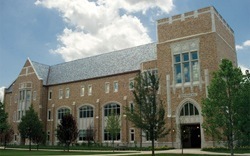
Stinson-Remick Hall has received LEED Gold Certification from the United States Green Building Council. The 160,000-square-foot College of Engineering facility, which was dedicated on September 3rd, houses a nanotechnology research center, a 9,000-square-foot semiconductor processing and device fabrication clean room, and an undergraduate interdisciplinary learning center.
The building’s sustainable features began with the site selection, located on the footprint of a demolished building (the University Club) in order not to reduce campus green space. 95% of construction waste materials (7,100 tons) was recycled, including wood, concrete, metal, brick, plastic, and drywall.
Stinson Remick’s energy usage is 13% to 15% more efficient than code as a result of a combination of efficiency technologies, including heat reclamation from exhaust air, cooling of clean rooms using outside air in winter, occupancy controlled lighting and HVAC, high efficiency lighting, and electricity and heating from a micro-turbine. The energy recovery system installed on the lab exhaust system alone is expected to save about $65,724 per year, and will pay for itself in under 8 years.
The roof has a photovoltaic solar array that produces 30kw of electricity for the building as well as a white roof membrane installed to reduce the heating load on the building in the summer months.
Many of the building materials used were manufactured regionally in order to reduce transportation impacts, including clay pavers, rebar for the concrete structure, the face brick, all the structural steel, and all the concrete. Reinforcing steel for the masonry walls, metal decking for the roof, structural steel for the penthouse, and interior wood doors are all made from recycled material. Water saving toilets and urinals equate to about 130,850 gallons of water saved per year and a native landscape and drip irrigation system was added to save 51% of normal water usage for irrigation.
Low VOC (volatile organic compound) materials were used for most interior materials, carpet, glues, sealants, and paints, and the building uses environmentally-friendly refrigerants in its cooling systems. In addition, over 75 electrical metering points track the building’s electrical usage and enable building users to pinpoint situations in which energy is being wasted.
Stinson-Remick is the third Notre Dame building to be LEED certified. Geddes Hall, the home of the University’s Center for Social Concerns and Institute for Church Life, and Ryan Hall also have received Gold certification.